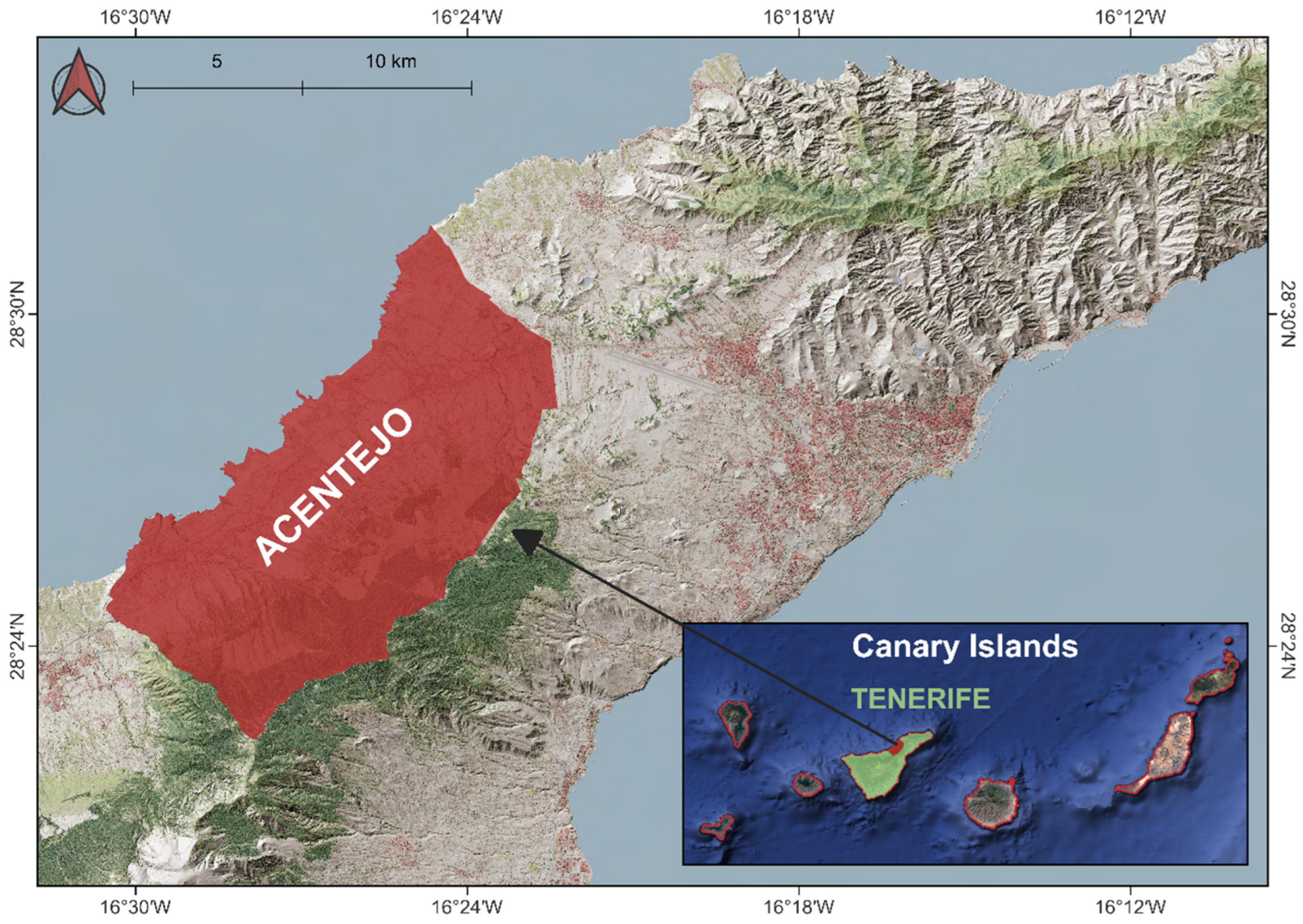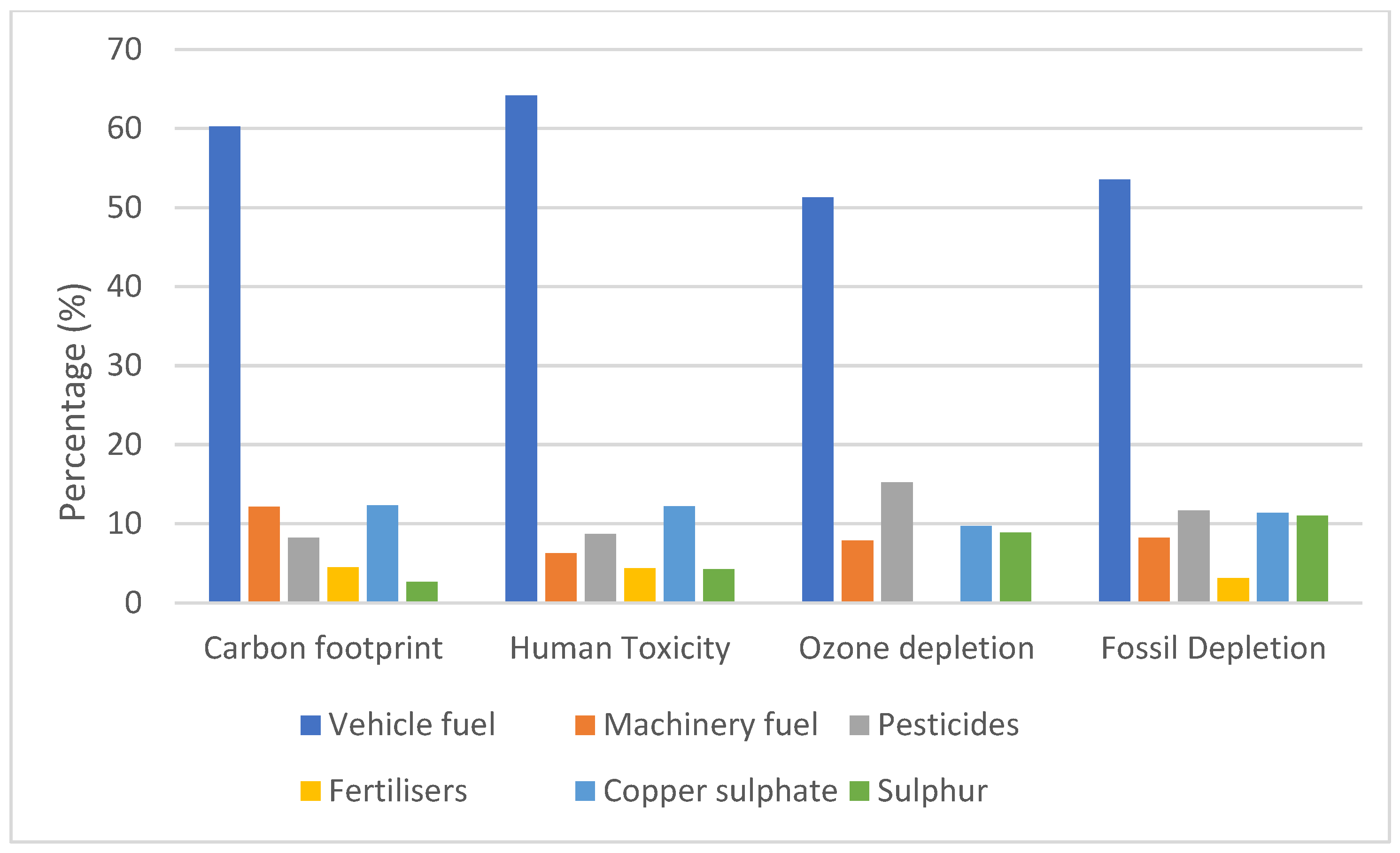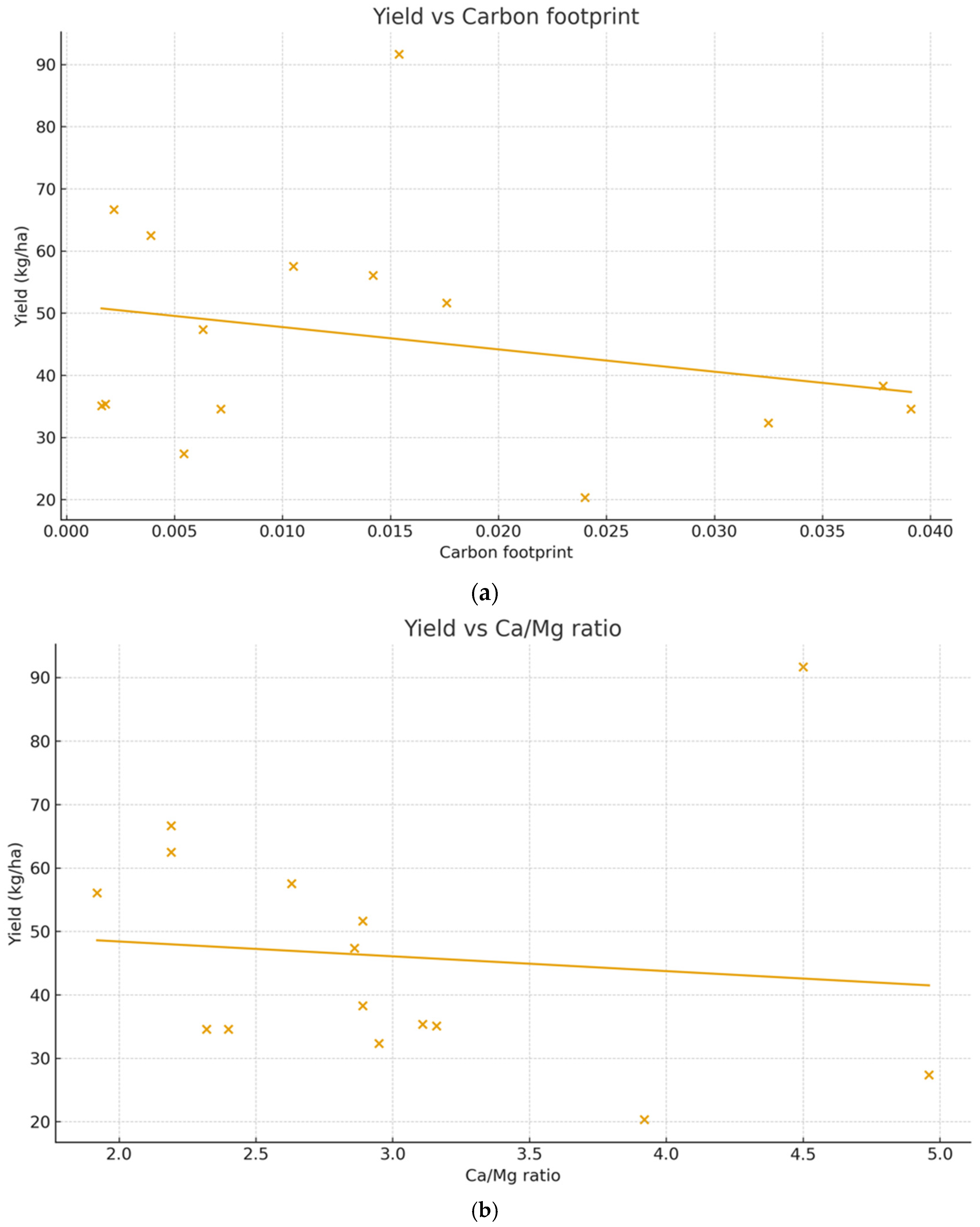Integrating Soil Diagnostics and Life Cycle Assessment to Enhance Vineyard Sustainability on a Volcanic Island (Tenerife, Spain)
Abstract
1. Introduction
- To quantify the environmental impacts associated with vineyard management practices through Life Cycle Assessment;
- To characterize the chemical and nutrient status of volcanic vineyard soils;
- To evaluate the relationship between soil fertility, yield performance, and environmental efficiency.
2. Materials and Methods
2.1. Study Area
2.2. Sample Characteristics
- Soil samples, collected and analyzed in a certified laboratory.
- Custom-designed questionnaire, administered in person to vineyard owners, managers, or technical staff.
- General vineyard information (e.g., location, area, altitude, training system).
- Agronomic inputs (e.g., quantities and types of fertilizers, phytosanitary products, amendments, irrigation).
- Field operations and mechanization (e.g., fuel consumption, equipment use, labor intensity).
- Production data (e.g., yields, grape varieties, observed practices).
2.3. Agronomic Analysis Methodology
Soil Sample Characterization
2.4. Environmental Impact Assessment
- Goal and scope definition.
- Life cycle inventory (LCI).
- Life cycle impact assessment (LCIA).
- Interpretation of results.
3. Results and Discussion
3.1. LCA Results
3.2. Soil Diagnostics
- Yield = −358.786 × (Carbon footprint) + 51.334 (R2 = 0.064; p = 0.363; n = 15).
- Yield = −2.337 × (Ca/Mg ratio) + 53.077 (R2 = 0.012; p = 0.699; n = 15).
4. Conclusions
Author Contributions
Funding
Institutional Review Board Statement
Informed Consent Statement
Data Availability Statement
Acknowledgments
Conflicts of Interest
References
- FAO. Land Statistics and Indicators (2000–2020): Global, Regional and Country Trends; Food and Agriculture Organization of the United Nations: Rome, Italy, 2023. [Google Scholar]
- International Organisation of Vine and Wine. State of the World Vine and Wine Sector in 2022; International Organisation of Vine and Wine: Dijon, France, 2023. [Google Scholar]
- González, P.A.; Dans, E.P.; González, M.M.H.; Blázquez, P.A.; Dacal, A.C.A.; Luzardo, O.P. Unveiling terroir: Evaluating the magnitude of the heterogeneity and its main drivers in the Canary Islands wines. Cogent. Food Agric. 2024, 10, 2334997. [Google Scholar] [CrossRef]
- Santamarta, J.C.; García-Gil, A.; del Cristo Expósito, M.; Casañas, E.; Cruz-Pérez, N.; Rodríguez-Martín, J.; Gimeno, V. The clean energy transition of heating and cooling in touristic infrastructures using shallow geothermal energy in the Canary Islands. Renew. Energy 2021, 171, 505–515. [Google Scholar] [CrossRef]
- Hernández, A.M.M. El paisaje vitícola de Canarias: Cinco siglos de historia. Ería Rev. Cuatrimest. Geogr. 2005, 68, 351–364. [Google Scholar]
- Machín, N.; Hontoria, M.; Luis, J.; Gonzalo, C. Variedades de vid en La Isla de Tenerife; Cabildo de Tenerife: Santa Cruz de Tenerife, Spain, 2019. [Google Scholar]
- ISTAC. Superficie Cultivada de Viñedo; Instituto Canario de Estadística: Santa Cruz de Tenerife, Spain, 2024. [Google Scholar]
- Vallejo Segovia, L.; Hilario Reyes, H. Estación Meteorológica de Bajo Coste Para el Entorno Agrícola; University of La Laguna: Santa Cruz de Tenerife, Spain, 2022. [Google Scholar]
- Godenau, D.; Suárez Sosa, S.J.; Febles Ramírez, M. Análisis de los Resultados de la Encuesta Rural Tenerife 2007; Área de Agricultura, Excmo, Cabildo Insular de Tenerife: Santa Cruz de Tenerife, Spain, 2009. [Google Scholar]
- Consejo Insular de Aguas de Tenerife. Plan Hidrológico de la Demarcación Hidrográfica de Tenerife: Revisión de tercer ciclo (2021–2027). In Documentos Iniciales: Programa, Calendario, Estudio General Sobre la Demarcación y Fórmulas de Consulta; Consejo Insular de Aguas de Tenerife: Santa Cruz de Tenerife, Spain, 2019. [Google Scholar]
- Compés López, R.; y Sotés Ruiz, V. El Sector Vitivinícola Frente al Desafío del Cambio Climático; Estrategias Públicas y Privadas de Mitigación y Adaptación en el Mediterráneo; Cajamar Caja Rural: Almería, Spain, 2018. [Google Scholar]
- ISTAC. Superficie Cultivada Superficie de Producción y Árboles Diseminados Según Productos Agrícolas Permanentes y Sistemas de Cultivo; Municipios e islas de Canarias por años, Instituto Canario de Estadística: Santa Cruz de Tenerife, Spain, 2021. [Google Scholar]
- García-Verdugo, D.L. Diagnóstico de la Viticultura en Canarias; Gobierno de Canarias: Santa Cruz de Tenerife, Spain, 2020. [Google Scholar]
- González Hernandez, G.; Hardisson de La Torre, A.; Arias León, J.J. Quantity of K, Ca, Na, Mg, Fe, Cu, Pb, Zn and ashes in DOC Tacoronte-Acentejo (Canary Islands, Spain) musts and wines. Z. Für Lebensm.-Unters. Und Forsch. 1996, 203, 517–521. [Google Scholar] [CrossRef] [PubMed]
- Lázaro-López, A.; Nota, J.; Hernández, Z. Propuesta de zonificación de suelos vitivinícolas en la Comarca Tacoronte-Acentejo (Tenerife, Islas Canarias): Una herramienta para la gestión territorial. In Proceedings of the VI Congreso Ibérico de la Ciencia del SueloAt, Santiago de Compostela, Spain, 22–25 June 2014. [Google Scholar]
- Mackenzie, D.E.; Christy, A.G. The role of soil chemistry in wine grape quality and sustainable soil management in vineyards. Water Sci. Technol. 2005, 51, 27–37. [Google Scholar] [CrossRef]
- Alonso González, P.; Parga-Dans, E.; Blázquez, P.A.; Luzardo, O.P.; Peña, M.L.Z.; González, M.M.H.; Rodríguez-Hernández, Á.; Andújar, C. Elemental Composition, Rare Earths and Minority Elements in Organic and Conventional Wines from Volcanic Areas: The Canary Islands (Spain). PLoS ONE 2021, 16, e0258739. [Google Scholar] [CrossRef]
- Alonso González, P.; Dans, E.P.; Dacal, A.C.A.; Peña, M.Z.; Luzardo, O.P. Differences in the levels of sulphites and pesticide residues in soils and wines and under organic and conventional production methods. J. Food Compos. Anal. 2022, 112, 104714. [Google Scholar] [CrossRef]
- Godenau, D.; Cáceres Hernández, J.J.; González Gómez, J.I. Tamaño, Costes y Viabilidad Empresarial en el Sector Vitiviní Cola de Canarias; Universidad de La Laguna: Santa Cruz de Tenerife, Spain, 2014. [Google Scholar]
- Laca, A.; Gancedo, S.; Laca, A.; y Díaz, M. Evaluación de los impactos ambientales asociados a la viticultura y la vinificación. Un estudio de caso en zonas de montaña. Environ. Sci. Pollut. Res. 2021, 28, 1204–1223. [Google Scholar] [CrossRef]
- Barroso Castillo, S.M.; Castellanos, I.D.M.P.; Cruz-Pérez, N.; Santamarta, J.C.; Alonso González, P. Environmental Impact Assessment of Vineyard and Winery Using Life Cycle Analysis on Volcanic Island: Tenerife. Sustainability 2025, 17, 4649. [Google Scholar] [CrossRef]
- Balafoutis, A.T.; Koundouras, S.; Anastasiou, E.; Fountas, S.; Arvanitis, K. Life cycle assessment of two vineyards after the application of precision viticulture techniques: A case study. Sustainability 2017, 9, 1997. [Google Scholar] [CrossRef]
- Rouault, A.; Beauchet, S.; Renaud-Gentie, C.; Jourjon, F. Life cycle assessment of viticultural technical management routes (TMRs): Comparison between an organic and an integrated management route. OENO One 2016, 50, 2. [Google Scholar] [CrossRef]
- Rinaldi, S.; Bonamente, E.; Scrucca, F.; Merico, M.C.; Asdrubali, F.; Cotana, F. Water and carbon footprint of wine: Methodology review and application to a case study. Sustainability 2016, 8, 621. [Google Scholar] [CrossRef]
- Falcone, G.; Strano, A.; Stillitano, T.; De Luca, A.I.; Iofrida, N.; Gulisano, G. Integrated sustainability appraisal of wine-growing management systems through LCA and LCC methodologies. Chem. Eng. Trans. 2015, 44, 223–228. [Google Scholar]
- Herrero, M.; Laca, A.; Laca, A.; Díaz, M. Application of life cycle assessment to food industry wastes. In Food Industry Wastes; Academic Press: Cambridge, MA, USA, 2020; pp. 331–353. [Google Scholar]
- Villanueva-Rey, P.; Vázquez-Rowe, I.; Moreira, M.T.; Feijoo, G. Comparative life cycle assessment in the wine sector: Biodynamic vs. conventional viticulture activities in NW Spain. J. Clean. Prod. 2014, 65, 330–341. [Google Scholar] [CrossRef]
- Meneses, M.; Torres, C.M.; Castells, F. Sensitivity analysis in a life cycle assessment of an aged red wine production from Catalonia, Spain. Sci. Total Environ. 2016, 562, 571–579. [Google Scholar] [CrossRef]
- Devasirvatham, P.; Gasol, C.M.; Dorado, J.; Férnandez-Quintanilla, C. Environmental impact and energy demand comparison of vineyards by the life cycle assessment methodology. In Proceedings of the XVI Congreso de la Sociedad Española de Malherbología, Pamplona, Spain, 25–27 October 2017; pp. 25–27. [Google Scholar]
- Coll, P.; Le Cadre, E.; Blanchart, E.; Hinsinger, P.; Villenave, C. Organic viticulture and soil quality: A long-term study in Southern France. Appl. Soil Ecol. 2011, 50, 37–44. [Google Scholar] [CrossRef]
- Gutiérrez-Gamboa, G.; Romanazzi, G.; Garde-Cerdán, T.; Pérez-Álvarez, E.P. A review of the use of biostimulants in the vineyard for improved grape and wine quality: Effects on prevention of grapevine diseases. J. Sci. Food Agric. 2019, 99, 1001–1009. [Google Scholar] [CrossRef]
- Godenau, D.; Suárez Sosa, S.J.; Gil Díaz, M.; Fernández López, L. Particularidades del marketing vitivinícola en zonas turísticas. El caso de la Denominación de Origen Tacoronte-Acentejo en Tenerife España. In Proceedings of the XXV Congreso Mundial de la Viña y el Vino, Paris, France, 19–23 June 2000. [Google Scholar]
- Casolani, N.; D’Eusanio, M.; Liberatore, L.; Raggi, A.; Petti, L. Life Cycle Assessment in the wine sector: A review on inventory phase. J. Clean. Prod. 2022, 379, 134404. [Google Scholar] [CrossRef]
- Vidergar, P.; Perc, M.; Lukman, R.K. A survey of the life cycle assessment of food supply chains. J. Clean. Prod. 2021, 286, 125506. [Google Scholar] [CrossRef]
- Meier, M.S.; Stoessel, F.; Jungbluth, N.; Juraske, R.; Schader, C.; Stolze, M. Environmental impacts of organic and conventional agricultural products–Are the differences captured by life cycle assessment? J. Environ. Manag. 2015, 149, 193–208. [Google Scholar] [CrossRef]
- Kolmans, E.; Vásquez, D. Manual de Agricultura Ecológica; Grupo de Agricultura Orgánica: Havana, Cuba, 1999. [Google Scholar]
- Soto, J.M.D.; Gutiérrez, A.D.R.; García, F.P.; Sandoval, O.A. Evaluación de color en suelos del Cerro de Denganthza, municipio de Francisco I. Madero, Hidalgo. Acta Univ. 2011, 21, 92–100. [Google Scholar] [CrossRef]
- Pontallier, P.; Salagoïty, M.H.; Ribéreau-Gayon, P. Intervention du bois de chêne dans l’évolution des vins rouges élevés en barriques. OENO One 1982, 16, 45–61. [Google Scholar] [CrossRef]
- Fernández, I.; Cabaneiro, A.; Carballas, T. Organic matter changes immediately after a wildfire in an Atlantic forest soil and comparison with laboratory soil heating. Soil Biol. Biochem. 1997, 29, 1–11. [Google Scholar] [CrossRef]
- Hernández, E.J.P. Caracterización y capacidad agrológica de los suelos de viñedo en el municipio de Fuencaliente de La Palma. Rev. Estud. Gen. Isla Palma 2007, 3, 631–666. [Google Scholar]
- Delmas, J. Fertilization de la Vigne; Sciences et Techniques de la Vigne; Riberau Gayon, J., Peynaud, E., Eds.; Ed. Dunod.: Paris, France, 1971; pp. 617–650. [Google Scholar]
- Figueruelo Ojeda, M.E. Contribución al Estudio de los Suelos y Nutrición Mineral de Viñas de la Zona Tacoronte-Santa Úrsula. Ph.D. Thesis, Universidad de La Laguna, Santa Cruz de Tenerife, Spain, 1986. [Google Scholar]
- FAO. Standard Operating Procedures for Soil Analysis: Volume 2.6—Cation Exchange Capacity and Exchangeable Bases; Organización de las Naciones Unidas para la Alimentación y la Agricultura: Rome, Italy, 2020. [Google Scholar]
- ISO 10390:2005; Soil Quality—Determination of pH. ISO: Geneva, Switzerland, 2005.
- ISO14040; Environmental Management—Life Cycle Assessment: Principles and Framework. International Organization for Standardization: Geneva, Switzerland, 2006; p. 20.
- ISO14044; Environmental Management—Life Cycle Assessment: Requirements and Guidelines. International Organization for Standardization: Geneva, Switzerland, 2006; p. 46.
- Arzoumanidis, I.; Salomone, R.; Petti, L.; Mondello, G.; Raggi, A. Is there a simplified LCA tool suitable for the agri-food industry? An assessment of selected tools. J. Clean. Prod. 2017, 149, 406–425. [Google Scholar] [CrossRef]
- Marson, A.; Masiero, M.; Modesti, M.; Scipioni, A.; Manzardo, A. Life cycle assessment of polyurethane foams from polyols obtained through chemical recycling. ACS Omega 2021, 6, 1718–1724. [Google Scholar] [CrossRef] [PubMed]
- Vangoni, E.; Cesaraccio, C.; Pirino, P.; Duce, P. The environmental role of small organic wineries: The case study of a multi-year assessment of a local Italian red wine. Int. J. Life Cycle Assess. 2024, 29, 469–482. [Google Scholar]
- Jourdaine, M.; Loubet, P.; Trebucq, S.; Sonnemann, G. A detailed quantitative comparison of the life cycle assessment of bottled wines using an original harmonization procedure. J. Clean. Prod. 2020, 250, 119472. [Google Scholar] [CrossRef]
- Mackie, K.A.; Müller, T.; Kandeler, E. Remediation of copper in vineyards—A mini review. Environ. Pollut. 2012, 167, 16–26. [Google Scholar] [CrossRef]
- Litskas, V.D.; Tzortzakis, N.; Stavrinides, M.C. Determining the carbon footprint and emission hotspots for the wine produced in Cyprus. Atmosphere 2020, 11, 463. [Google Scholar] [CrossRef]
- Valderrama, J.O.; Espíndola, C.; Quezada, R. Huella de Carbono, un Concepto que no puede estar Ausente en Cursos de Ingeniería y Ciencias. Form. Univ. 2011, 4, 3–12. [Google Scholar] [CrossRef]
- Simões, C.L.; Simoes, R.; Gonçalves, A.S.; Nunes, L.J. Environmental analysis of the valorization of Woody biomass residues: A comparative study with vine pruning leftovers in Portugal. Sustainability 2023, 15, 14950. [Google Scholar] [CrossRef]
- Margni, M.D.P.O.; Rossier, D.; Crettaz, P.; Jolliet, O. Life cycle impact assessment of pesticides on human health and ecosystems. Agric. Ecosyst. Environ. 2002, 93, 379–392. [Google Scholar] [CrossRef]
- Xue, X.; Hawkins, T.R.; Ingwersen, W.W.; Smith, R.L. Demonstrating an approach for including pesticide use in life-cycle assessment: Estimating human and ecosystem toxicity of pesticide use in Midwest corn farming. Int. J. Life Cycle Assess. 2015, 20, 1117–1126. [Google Scholar] [CrossRef]
- Medel-Jiménez, F.; Piringer, G.; Gronauer, A.; Barta, N.; Neugschwandtner, R.W.; Krexner, T.; Kral, I. Modelling soil emissions and precision agriculture in fertilization life cycle assessment-A case study of wheat production in Austria. J. Clean. Prod. 2020, 380, 134841. [Google Scholar] [CrossRef]
- Eslava-Lecumberri, F.J.; Jiménez-Ballesta, R. Delineating vineyard management zones: Intrafield spatial variability of soil properties of carbonate vineyard soils. Eur. J. Soil Sci. 2024, 75, e70029. [Google Scholar] [CrossRef]
- Brady, N.C.; Weil, R.R. Elements of the Nature and Properties of Soils, 3rd ed.; Pearson Education: London, UK, 2010. [Google Scholar]
- Ruiz, J.M.; Romero, L. Relationship between potassium fertilisation and nitrate assimilation in leaves and fruits of cucumber (Cucumis sativus) plants. Ann. Appl. Biol. 2002, 140, 241–245. [Google Scholar] [CrossRef]
- Isleib, J. Soil Calcium-to-Magnesium Ratios Should Not Concern Most Farmers; Michigan State University Extension: East Lansing, MI, USA, 2016. [Google Scholar]
- Leiva Soto, A.; Culman, S.W.; Herms, C.; Sprunger, C.; Doohan, D. Managing soil acidity vs. soil Ca: Mg ratio: What is more important for crop productivity? Crop. Forage Turfgrass Manag. 2023, 9, e20210. [Google Scholar] [CrossRef]




| Sample Code | Municipality | Surface Area (m2) | Production (kg) | Yield (kg/ha) | Altitude (m2) | Training System * |
|---|---|---|---|---|---|---|
| M27 | Santa Úrsula | 1200 | 750 | 6.250 | 550 | Trellis |
| M50 | La Laguna | 1627 | 1491 | 9.164 | 429 | Trellis and traditional |
| M47 | Tacoronte | 1784 | 631 | 3.536 | 669 | Traditional |
| M46 | Tacoronte | 1800 | 632 | 3.511 | 644 | Trellis |
| M19 | Santa Úrsula | 2100 | 575 | 2.738 | 650 | Trellis |
| M26 | La Matanza | 2822 | 976 | 3.458 | 475 | Traditional |
| M28 | La Matanza | 3921 | 2025 | 5.164 | 375 | Trellis |
| M22 | Tacoronte | 5326 | 3550 | 6.665 | 320 | Trellis |
| M20 | La Victoria | 6400 | 1300 | 2.031 | 410 | Traditional |
| M24 | Tacoronte | 7883 | 2724 | 3.455 | 530 | Trellis and traditional |
| M18 | La Victoria | 8200 | 2650 | 3.231 | 625 | Trellis |
| M12 | Santa Úrsula | 10,635 | 4070 | 3.826 | 238 | Trellis |
| M49 | Tegueste | 13,189 | 7588 | 5.753 | 368 | Trellis |
| M48 | Tegueste | 15,796 | 8858 | 5.607 | 351 | Trellis |
| M23 | La Laguna | 68,840 | 32,600 | 4.735 | 435 | Trellis |
| Yield (kg/ha) | Carbon Footprint | Ca/Mg Ratio | OM (%) | Mg (mg·kg−1) | |
|---|---|---|---|---|---|
| Yield (kg/ha) | 1.000 (p = 0.0000) | −0.253 (p = 0.3632) | −0.109 (p = 0.6987) | −0.095 (p = 0.7373) | 0.237 (p = 0.3954) |
| Carbon footprint | −0.253 (p = 0.3632) | 1.000 (p = 0.0000) | −0.036 (p = 0.8973) | 0.156 (p = 0.5791) | 0.173 (p = 0.5363) |
| Ca/Mg ratio | −0.109 (p = 0.6987) | −0.036 (p = 0.8973) | 1.000 (p = 0.0000) | 0.414 (p = 0.1253) | −0.486 (p = 0.0665) |
| OM (%) | −0.095 (p = 0.7373) | 0.156 (p = 0.5791) | 0.414 (p = 0.1253) | 1.000 (p = 0.0000) | −0.538 (p = 0.0386) |
| Mg (mg·kg−1) | 0.237 (p = 0.3954) | 0.173 (p = 0.5363) | −0.486 (p = 0.0665) | −0.538 (p = 0.0386) | 1.000 (p = 0.0000) |
Disclaimer/Publisher’s Note: The statements, opinions and data contained in all publications are solely those of the individual author(s) and contributor(s) and not of MDPI and/or the editor(s). MDPI and/or the editor(s) disclaim responsibility for any injury to people or property resulting from any ideas, methods, instructions or products referred to in the content. |
© 2025 by the authors. Licensee MDPI, Basel, Switzerland. This article is an open access article distributed under the terms and conditions of the Creative Commons Attribution (CC BY) license (https://creativecommons.org/licenses/by/4.0/).
Share and Cite
Castillo, S.M.B.; de Martín-Pinillos Castellanos, I.; Alonso González, P. Integrating Soil Diagnostics and Life Cycle Assessment to Enhance Vineyard Sustainability on a Volcanic Island (Tenerife, Spain). Resources 2025, 14, 177. https://doi.org/10.3390/resources14120177
Castillo SMB, de Martín-Pinillos Castellanos I, Alonso González P. Integrating Soil Diagnostics and Life Cycle Assessment to Enhance Vineyard Sustainability on a Volcanic Island (Tenerife, Spain). Resources. 2025; 14(12):177. https://doi.org/10.3390/resources14120177
Chicago/Turabian StyleCastillo, Santiago M. Barroso, Ignacio de Martín-Pinillos Castellanos, and Pablo Alonso González. 2025. "Integrating Soil Diagnostics and Life Cycle Assessment to Enhance Vineyard Sustainability on a Volcanic Island (Tenerife, Spain)" Resources 14, no. 12: 177. https://doi.org/10.3390/resources14120177
APA StyleCastillo, S. M. B., de Martín-Pinillos Castellanos, I., & Alonso González, P. (2025). Integrating Soil Diagnostics and Life Cycle Assessment to Enhance Vineyard Sustainability on a Volcanic Island (Tenerife, Spain). Resources, 14(12), 177. https://doi.org/10.3390/resources14120177






